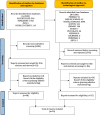Advancements in additive manufacturing for video laryngoscopes: a comprehensive scoping and technological review
- PMID: 38098125
- PMCID: PMC10720237
- DOI: 10.1186/s13643-023-02406-y
Advancements in additive manufacturing for video laryngoscopes: a comprehensive scoping and technological review
Erratum in
-
Correction: Advancements in additive manufacturing for video laryngoscopes: a comprehensive scoping and technological review.Syst Rev. 2024 Jan 17;13(1):31. doi: 10.1186/s13643-024-02453-z. Syst Rev. 2024. PMID: 38233955 Free PMC article. No abstract available.
Abstract
The global healthcare crisis with the COVID-19 pandemic has placed a significant overwhelming demand for intubation procedures and the need for reliable and accessible video laryngoscopes. The purpose of this scoping and technological review is to provide a comprehensive overview of the current state of the art, covering the period from 2007 to 2022, pertaining to the manufacturing process, characteristics, and validation of video laryngoscopes produced using additive manufacturing techniques. Following the guidelines outlined in the Preferred Reporting Items for Systematic Reviews and Meta-Analyses extension for Scoping Reviews (PRISMA-ScR), an exhaustive search was conducted across nine prominent databases (PubMed, Web of Science, Scopus, Cochrane, Prospero, Scielo, Embase, Lilacs, Virtual Health Libraries-VHL) and four patent databases (EPO/ESPACENET, WIPO/PATENTSCOPE, National Institute of Industrial Property (INPI), Google Patents). The main materials utilized for the impression, as well as the physical characteristics of the device are introduced at first. Crucial aspects to facilitate proper visualization of the anatomical structures during endotracheal intubation as the optimal angulation of the blade, the mechanical resistance of the device, traction force on the jaw, intubation time, and the experimental methods employed to validate its performance were reviewed in terms of their recent advances.
Keywords: Additive manufacturing; Fused deposition modeling; Intubation equipment; Technological aspects; Video laryngoscopes.
© 2023. The Author(s).
Conflict of interest statement
The authors declare that they have no competing interests.
Figures
References
-
- Ataman AK, Altıntas E. Comparison of a commercial 3D fabricated laryngoscope (Airangel ®) with a widely-used video laryngoscope (Glidescope®): randomized controlled cross-over study. Trends Anaesth Crit Care. 2021;40:35–40. doi: 10.1016/j.tacc.2021.05.009. - DOI
-
- Subramaniam SR, Samykano M, Selvamani SK, Ngui WK, Kadirgama K, Sudhakar K, Idris MS. 3D printing: overview of PLA progress. AIP Conf Proc. 2019;2059:020015. doi: 10.1063/1.5085958. - DOI
-
- Cai X (2009) Laryngoscope. CN patent 101366623A. https://worldwide.espacenet.com/patent/search/family/040410734/publicati.... Accessed July 28 2022
-
- Rajan K, Samykano M, Kadirgama K, Harun WSW, Rahman MM. Fused deposition modeling: process, materials, parameters, properties, and applications. Int J Adv Manuf Technol. 2022;120:1531–1570. doi: 10.1007/s00170-022-08860-7. - DOI
Publication types
MeSH terms
Grants and funding
LinkOut - more resources
Full Text Sources
Research Materials


